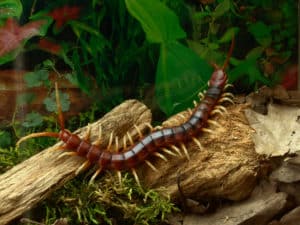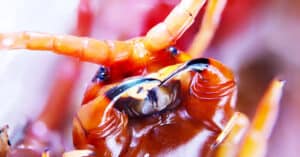House centipedes are common and notorious for living in our homes. They may look different from the average centipede, but they still have similar traits. House centipedes may look fearsome, but there are some benefits to having them around.
In North America, house centipedes are typical, but they also live in other parts of the world. These species get their name because they will often make their home in our homes, as they are sustainable habitats. Some folks even admire them since they reduce the population of other pests.
If you have house centipedes in your home, you may not want to get rid of them. They are often seen as natural pest control, but you should still be wary. House centipedes can spend their entire lifetime indoors, and learning about them can help you decide if you want to keep them.
What Are House Centipedes?

House centipedes can grow to four inches long, counting the appendages.
©Igor Nikushin/Shutterstock.com
House centipedes (Scutigera ceoleoptrata) are one species of centipede out of the 8,000 discovered. When mature, they have 15 pairs of legs stretched on each side, along with two long antennae on their head. Their body is small and worm-like, which makes it hard to tell what direction they are facing from a distance. They are tan in color with dark bands across their body.
The largest house centipede will grow to four inches long when counting its appendages. These insects can run at around 0.4 meters per second and are tiny enough to fit through the smallest of crevices. It is thought that house centipedes originated in the Mediterranean but have managed to grow their range around the globe. Their ability to coexist with humans has helped them do that.
Where To Find House Centipedes
House centipedes will often live in homes, apartments, and other buildings. They can live outside, but indoors make perfect habitats for them and have allowed them to spread their species’ range. From fall to winter, they are more likely to find warmth from the outside temperatures.
Bathrooms, basements, and other damp dark places are their preferred habitat. They will hide under debris or stay in darkness during daylight. Common pests like roaches will attract this species, and that is why some people let them live in their homes. They are less annoying to other pests and will help exterminate them.
Why Are House Centipedes Beneficial?

House centipedes help to get rid of unwanted pests in the home like insects or spiders.
©iStock.com/Víctor Suárez Naranjo
Centipedes are carnivores and ruthless hunters. The house centipede is nature’s exterminator and will hunt down pests. Homes with a high population of indoor pests will attract a centipede. Other local centipede species can also find a way into your home, but the house centipede is notorious for living with people.
The house centipede should not be killed because it is helpful in getting rid of common unwanted pests like insects or spiders. House centipedes have an appetite helpful in pest control.
House centipedes will often prey on:
- Bed Bugs
- Cockroaches
- Ants
- Moths
- Beetles
- Termites
- Earwigs
- Silverfish
House centipedes are a great natural defense for dealing with these pests. Some believe that a house centipede in the home is better than dealing with the critters they hunt. They are seldom seen since they are nocturnal, but are silent assassins to small species.
Deciding if you want this species in your home is your choice as they have some benefits. They do not damage property or bring health risks, but they also have some downsides.
Are House Centipedes Dangerous?

House centipedes have a weaker bite compared to other centipedes.
©zaidi razak/Shutterstock.com
House centipedes are not dangerous but not harmless either. House centipedes are venomous and administer it through their bite. They have a weaker bite compared to other centipedes.
When bitten or stung, most people will only have mild symptoms. Redness and pain are common. Some individuals, if sensitive, have stronger reactions like nausea, dizziness, fever, and swelling. Most smaller species of centipede bites are harmless, even for children or animals.
Getting bit by a house centipede is rare, as they will only bite when provoked. Still, they would rather escape before attacking. Albeit, there are certain ways to deter them.
What Attracts House Centipedes And What Prevents Them?
Insects and prey that are food for the house centipede are what attract this species. Getting rid of their food source will make it less likely they will settle in. Also, clean and fill openings they can crawl into. House centipedes are small, and they creep through orifices in basements, bathrooms, and other moist areas.
House centipedes do not damage property and do less damage than other pests. That is why most people let them do their job of eliminating other critters. Cleaning up your home, blocking off moist hiding places, eliminating food sources, and using an indoor bug repellent is the best way to get rid of house centipedes.
It is up to you to decide if you want these multi-legged creatures in your home. They can provide free pest control, but they look creepy and sting. Other centipede species can also be found indoors. The house centipede is best at finding its way into our homes and is less dangerous.
The photo featured at the top of this post is © iStock.com/Víctor Suárez Naranjo
Thank you for reading! Have some feedback for us? Contact the AZ Animals editorial team.






